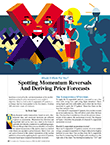Letters To The Editor
January 2012 Letters To The Editor
The editors of S&C invite readers to submit their opinions and information on subjects relating to technical analysis and this magazine. This column is our means of communication with our readers. Is there something you would like to know more (or less) about? Tell us about it. Without a source of new ideas and subjects coming from our readers, this magazine would not exist.
Address your correspondence to: Editor, Stocks & Commodities, 4757 California Ave. SW, Seattle, WA 98116-4499, or E-mail to editor@traders.com. All letters become the property of Technical Analysis, Inc. Letter-writers must include their full name and address for verification. Letters may be edited for length or clarity. The opinions expressed in this column do not necessarily represent those of the magazine. —Editor
X-SEQUENTIALS
 Editor,
Editor,
First, let me say how much I enjoy your magazine. In fact, today I renewed my subscription.
I recently read with interest the article by Devin Sage “Spotting Momentum Reversals And Deriving Price Forecasts”(Stocks & Commodities, November 2011).
In the article’s conclusion, the author lists three variations of the X-sequentials X7 pattern, but nowhere does he give examples of when and how to apply these variations.
Will the author be writing another article to expand on these variations? The article leaves the reader hanging for more information.
Also, how can one contact the author? Is there an English edition of his book, Besser Traden Mit X-sequentials, and where can any edition of the book be purchased?
Larry Escott
As for the book’s availability, Amazon.de carries it, for one, but it does not look as though there is an English translation.
A follow-up article is not planned at this point, but you can contact the author in care of this magazine at Editor@Traders.com.—Editor
TRADING PSYCHOLOGY ARTICLES
 Editor,
Editor,
Is it possible to dedicate at least few pages each issue to the subject of trading psychology? We have so much on technical systems, but our human brain needs an equal amount of psych support from the experienced traders.
Vijay Ramachandran
See our most recent article about trading psychology in the November 2011 issue by Jamie Theiss titled “Coach Yourself To Trading Success.”
We have published many articles over the years on trading psychology, and we will certainly keep your request in mind for the future. You can peruse our article archives at our website, Traders.com, for articles on trading psychology. All subscriptions to Stocks & Commodities now come with digital access to our past article archives. Here are just a few articles to mention on the topic of trading psychology:
- “How Fit Are You For Trading?” by Ned Gandevani, PhD, V.21:6
- “Trading In The Moment” by Adrienne Laris Toghraie, V.15:4
- “Emotionally Intelligent Trading” by Eliot Brenner, PhD, V.22:9
- “How Do You Make A Trading Decision?” by Simon Vine, V.20:11
You are correct that the ability to manage a trade and control your emotions are equally important parts of trading.—Editor
COACH YOURSELF TO TRADING SUCCESS
 Editor,
Editor,
I really enjoyed Jamie Theiss’ November
2011 article in Stocks & Commodities on developing a trading plan. His article does a great job of identifying how to learn from your plan.
I have researched how to develop a good trading plan, but I have not had much luck in putting one together. I find there is not enough discussion from the so-called stock gurus on trading plans.
Does Theiss have examples of a trading plan to use, or can he recommend a source for developing a useful trading plan? I really like his idea of tying a chart to the optimum trade setup for reference.
Daniel
Author Jamie Theiss replies:
Thanks for reading and for the kind words.
You’re right, there isn’t much out there on how to write a effective trading plan. First, let me define what kind of trading plan I am talking about, since there is some confusion about what a trading plan actually is. The kind of plan I am speaking of is a trading strategy for daytrading, rather than a business plan for trading.
Of course, there’s nothing wrong with having a business plan for trading — in fact, you should have one of those as well. But I have seen examples of business plans for trading that run 20–70 pages, and that’s not what I am talking about here. Unfortunately, most plan examples are of the business plan sort. Those plans get stuffed into a drawer. What a trader needs is something right in front of you at all times for reference, and there is no way you are going to read a 20-page plan before you enter and exit each intraday trade.
I suggest getting a 3x5 index card. Then write down a few if-then scenarios for entering and exiting your trades. That is your trading strategy. Then print out the cheat chart that I mentioned in my article to match that particular strategy. Those two things are what you need to have in front of you every day so you can match your entries and exits to that written strategy. All decisions are premade, so you don’t have to think so much while the market is gyrating and sending possibly conflicting signals.
In my May 2011 Stocks & Commodities article, “Gap Fill And Go,” I expounded into more detail on that strategy. But it can easily be distilled onto a 3x5 index card. That and my cheat chart account for more than 80% of all my trades (one plan for long and one plan for short).
As another example, the method presented in my August 2011 Stocks & Commodities article, “The V-Bottom Buy Setup,” came straight from my 3x5 card and cheat chart, only expanded with more detail. That setup accounts for less than 10% of my trades, but it is so effective that I get more than 90% accuracy with it.
You don’t need to have too many strategies. Mastering just one could help make the difference between earning a living by trading or not. Mastering two could help earn you a nice living. By “mastering,” I mean many hundreds and hundreds of trades in all kinds of market conditions over a few years. Fifty trades over six months is not mastering it.
Let me know if you need more clarification.
WHIPSAWS
Editor,
One of the most frustrating things that occurs in a trend-following system is the whipsaw. It gets you out of a profitable trade and eats into your potential profits. I would like to see an article on how to identify when a whipsaw is occurring, when to ignore it (despite the drawdown that may occur), and when to get back in early, based on an analysis of high probability.
Thanks for all the work you do.
Scott McWilliams
CHAT ROOMS LISTING?
Editor,
I have been picking up Stocks & Commodities at the newsstand since 2008, but I don’t ever recall seeing the category of futures/forex trading rooms in your Traders’ Resource section. Does such a compilation exist? A search at your website, Traders.com, didn’t produce any leads.
Jason Aleksei
No, unfortunately, it’s not a list we have compiled at our site. It’s a good suggestion.—Editor
LARRY WILLIAMS AND GEORGE LINDSAY
Editor,
Interestingly, the November 2011 issue of Stocks & Commodities had both an article on the methods of George Lindsay and an interview with Larry Williams. If I remember correctly, in the 1960s, Larry Williams promoted a book by George Lindsay. It would be interesting to get Williams’ comments on Lindsay now.
Tom Schlobohm
Larry Williams replies:
George Lindsay was a friend who spoke with me at numerous events in the mid- to late 1960s. George was a true out-of-the-box thinker on many topics. However, I believe you may be thinking of a book by Charles Lindsay, although I never promoted it.